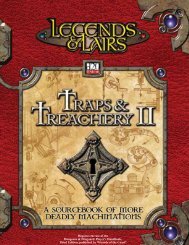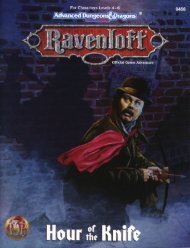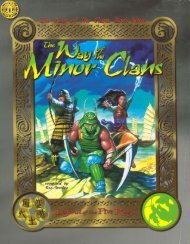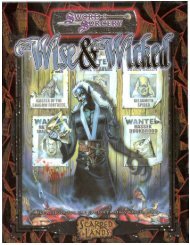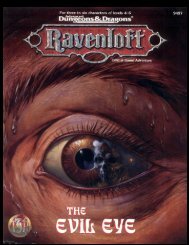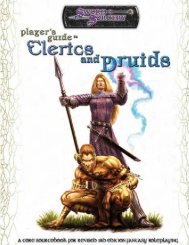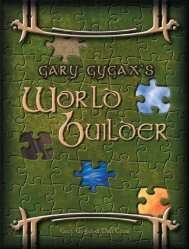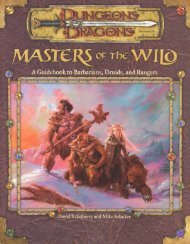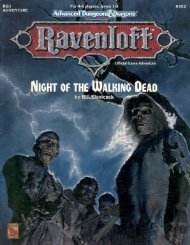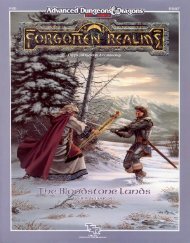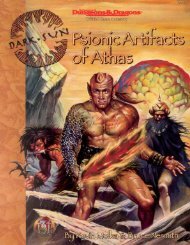Mythic Vistas: SpirosBlaak - Property Is Theft!
Mythic Vistas: SpirosBlaak - Property Is Theft!
Mythic Vistas: SpirosBlaak - Property Is Theft!
Create successful ePaper yourself
Turn your PDF publications into a flip-book with our unique Google optimized e-Paper software.
The customs, beliefs, and habits of the duchies usually differ from one to the next. This chapter presents some points of note. The new races<br />
mentioned within this chapter are fully detailed in Chapter Seven: Races.<br />
Dress<br />
Commoners and tradesmen wear durable and practical clothing to<br />
suit their responsibilities. Few can afford to adorn themselves in the<br />
silks, hoses, and fine gowns of the wealthy or the nobility, nor do<br />
they wish to. Simplicity of dress is the norm, but there are obvious<br />
exceptions. Faedians, for instance, wear almost nothing, and they are<br />
unashamed of nudity, oen causing scandals whenever a Faedian<br />
visits a “civilized” community. Furthermore, the orcs of the Roaming<br />
Plains traditionally dress in the skins of their kills, whereas the<br />
dwarves of Nolmedron consider light armor to be casual wear.<br />
Education<br />
Very few advanced schools or colleges exist for the lower social<br />
classes, except in Askalan, where the opposite is true. However,<br />
a typical urbanite of the Archduchy can aend community<br />
schools, where he learns reading and some arithmetic. Tradesmen,<br />
entertainers, and other professions requiring records or legers<br />
generally have a greater understanding of these maers due to the<br />
nature of their professions.<br />
Well-to-do commoners, on the other hand, possess a fair<br />
understanding of leers, intermediate mathematics are more familiar,<br />
and some rudimentary principles of science are broached. Still, most<br />
schooling at this social level is informal, learned from one’s family or<br />
by paying a nearby tradesman to tutor children during his spare time.<br />
The wealthy and noble classes, however, may avail themselves<br />
of the best academies and private tutors money can buy. Members<br />
of the upper class usually speak many tongues and know advanced<br />
mathematics, scientific elements and theories, philosophy, religion,<br />
and history. They also generally know something about other<br />
cultures, although they may not always be open-minded about them.<br />
Laws<br />
The rulers of each duchy set laws within their dominions. The<br />
Archduke or Archduchess only forces implementation of the most<br />
widely applicable regulations. Although most such regional decrees<br />
are similar in design and application to those of their neighbors, the<br />
finer points, such as sentencing, vary widely. There are, however,<br />
several laws enforced by just one or a few duchies that stand out from<br />
most others. For example, only Vas places restrictions on arcane magic.<br />
No maer where in the Archduchy one goes, however, it is clear<br />
centuries of conflict hardened its citizens against criminals and the<br />
downtrodden, for the citizenry heartily believes the law requires<br />
harsh justice to maintain order. Therefore, the is oen punishable<br />
by mutilation, murder with execution, and so on. Despite this hard<br />
stance on crime, it remains as prevalent in the Archduchy today as<br />
ever it did.<br />
Customs and Society<br />
Another legal commonality throughout the Archduchy (with a<br />
few exceptions) is the treatment of kavbroed and other non-humans<br />
as second-class citizens (at best) in the eyes of the law. Even when<br />
the actual leer of the law does not show them disfavor, their fellow<br />
citizens and agents of the law, including the magistrates and courts,<br />
still discriminate against them and treat them poorly. Kavraen, on the<br />
other hand, are an entirely different maer: a sweeping law granting<br />
all citizens the right to execute kavraen on sight. The few kavraen<br />
existing in the cities of man do so illegally, and they are usually ousted<br />
by their inability to control their shapechanging during full moons, an<br />
ability the kavbroed have long mastered.<br />
Superstitions<br />
Superstitions are common in any society, and each race, community,<br />
and social class in the Archduchy has its own. In general, what<br />
separates superstition from religion and magic is the fact that<br />
superstitious beliefs, while widely and firmly held, are generally<br />
inaccurate, sometimes dangerously so.<br />
Two such beliefs that are common to much of the population of<br />
the Archduchy are the Day of Hallowing Exemption and the power<br />
of “red silver.” (For an example of a superstition that is only partially<br />
inaccurate, see the practice of blood-pricking in the description of<br />
Kavbroed on page 70.)<br />
The Day of Hallowing Exemption<br />
On this Archduchy-wide holy day (see page 21) the human<br />
population of <strong>SpirosBlaak</strong> believe that the powers of the kav are<br />
held in check by the sacred energies that suffuse the land. The exact<br />
nature of this restriction on lycanthropes is debatable: in Hiltaenos<br />
it is believed that a kav’s bite doesn’t transmit lycanthropy on the<br />
Day of Hallowing, while in <strong>SpirosBlaak</strong> itself they believe that<br />
weres are unable to change form on that day. Unfortunately for both<br />
kav and human, the isolated counter-examples reported following<br />
an unsuccessful or tragic Hallowing Hunt are unable to dent the<br />
common folk’s belief in the Exemption.<br />
Red Silver<br />
The ability of silver to provide protection from lycanthropes is well<br />
known in the Archduchy, but unfortunately silver is too expensive for<br />
most commoners to be able to avail themselves of its protection. Thus<br />
many humans, goblins, halflings, and half-elves make it a general<br />
practice to carry on their persons at all times an amulet made of<br />
argentum (an alloy of copper and silver also called “red silver” for its<br />
color; see Money, page 118), a weapon plated with the alloy, or at the<br />
very least an argentum coin or two. Upon the birth of a baby in the<br />
Archduchy, well-wishers oen present to the parents argentum coins<br />
pierced and strung on cords to be placed around the child’s neck, at



